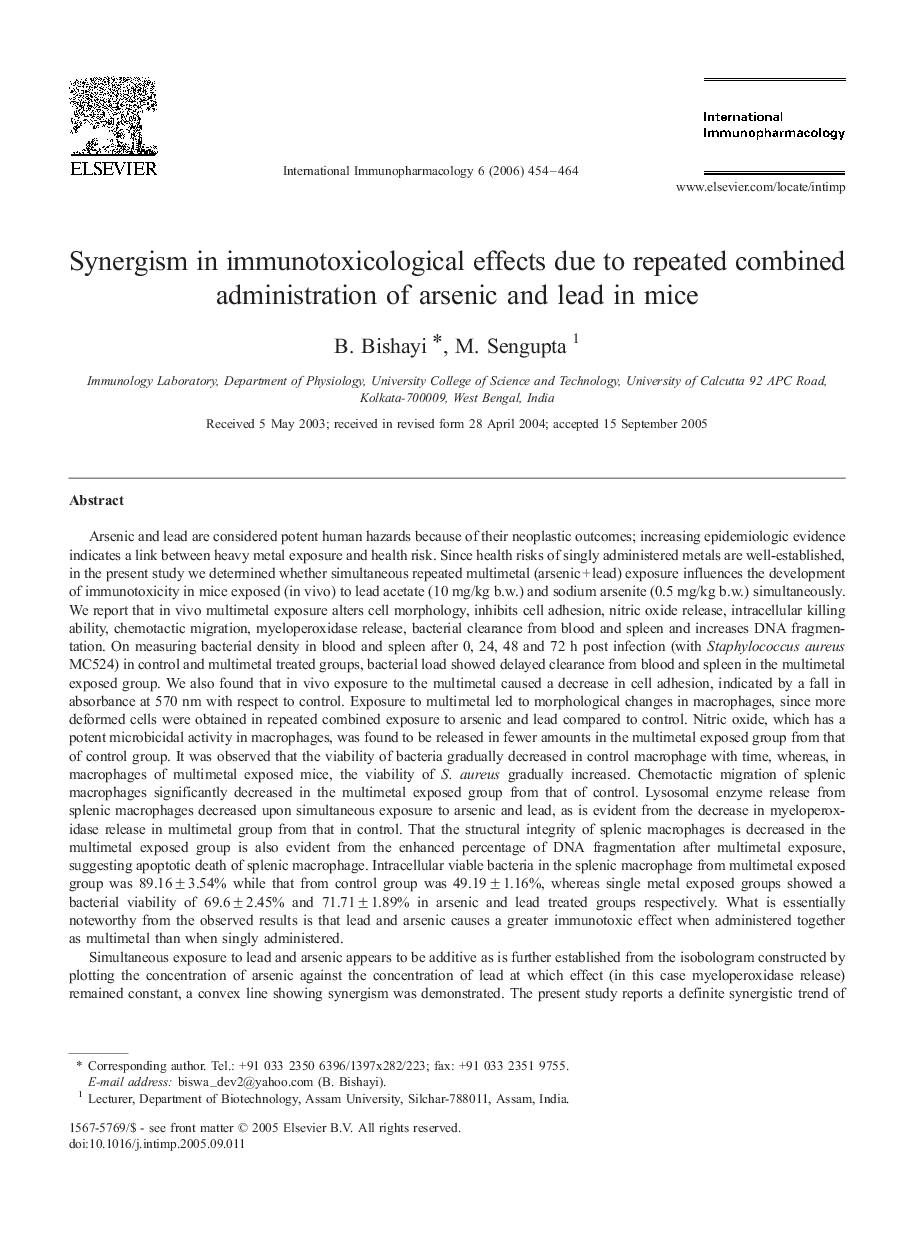| کد مقاله | کد نشریه | سال انتشار | مقاله انگلیسی | نسخه تمام متن |
|---|---|---|---|---|
| 2542439 | 1122702 | 2006 | 11 صفحه PDF | دانلود رایگان |

Arsenic and lead are considered potent human hazards because of their neoplastic outcomes; increasing epidemiologic evidence indicates a link between heavy metal exposure and health risk. Since health risks of singly administered metals are well-established, in the present study we determined whether simultaneous repeated multimetal (arsenic + lead) exposure influences the development of immunotoxicity in mice exposed (in vivo) to lead acetate (10 mg/kg b.w.) and sodium arsenite (0.5 mg/kg b.w.) simultaneously. We report that in vivo multimetal exposure alters cell morphology, inhibits cell adhesion, nitric oxide release, intracellular killing ability, chemotactic migration, myeloperoxidase release, bacterial clearance from blood and spleen and increases DNA fragmentation. On measuring bacterial density in blood and spleen after 0, 24, 48 and 72 h post infection (with Staphylococcus aureus MC524) in control and multimetal treated groups, bacterial load showed delayed clearance from blood and spleen in the multimetal exposed group. We also found that in vivo exposure to the multimetal caused a decrease in cell adhesion, indicated by a fall in absorbance at 570 nm with respect to control. Exposure to multimetal led to morphological changes in macrophages, since more deformed cells were obtained in repeated combined exposure to arsenic and lead compared to control. Nitric oxide, which has a potent microbicidal activity in macrophages, was found to be released in fewer amounts in the multimetal exposed group from that of control group. It was observed that the viability of bacteria gradually decreased in control macrophage with time, whereas, in macrophages of multimetal exposed mice, the viability of S. aureus gradually increased. Chemotactic migration of splenic macrophages significantly decreased in the multimetal exposed group from that of control. Lysosomal enzyme release from splenic macrophages decreased upon simultaneous exposure to arsenic and lead, as is evident from the decrease in myeloperoxidase release in multimetal group from that in control. That the structural integrity of splenic macrophages is decreased in the multimetal exposed group is also evident from the enhanced percentage of DNA fragmentation after multimetal exposure, suggesting apoptotic death of splenic macrophage. Intracellular viable bacteria in the splenic macrophage from multimetal exposed group was 89.16 ± 3.54% while that from control group was 49.19 ± 1.16%, whereas single metal exposed groups showed a bacterial viability of 69.6 ± 2.45% and 71.71 ± 1.89% in arsenic and lead treated groups respectively. What is essentially noteworthy from the observed results is that lead and arsenic causes a greater immunotoxic effect when administered together as multimetal than when singly administered.Simultaneous exposure to lead and arsenic appears to be additive as is further established from the isobologram constructed by plotting the concentration of arsenic against the concentration of lead at which effect (in this case myeloperoxidase release) remained constant, a convex line showing synergism was demonstrated. The present study reports a definite synergistic trend of immunotoxicity during simultaneous exposure to arsenic and lead, that is, a multimetal challenge, as compared to the effects of independent exposure to them.
Journal: International Immunopharmacology - Volume 6, Issue 3, March 2006, Pages 454–464